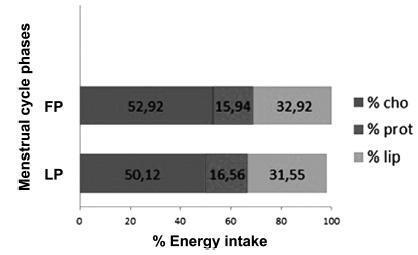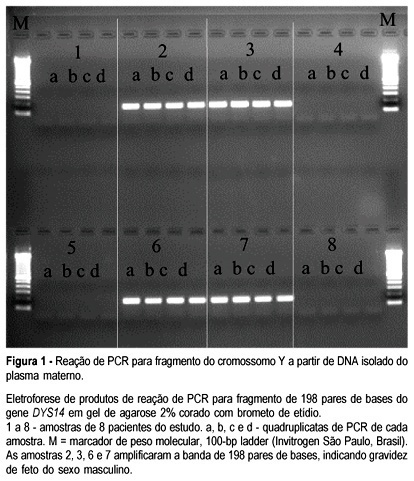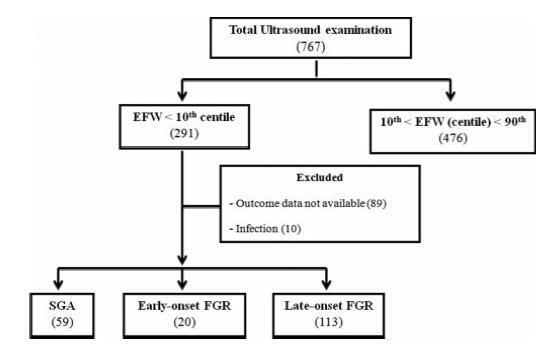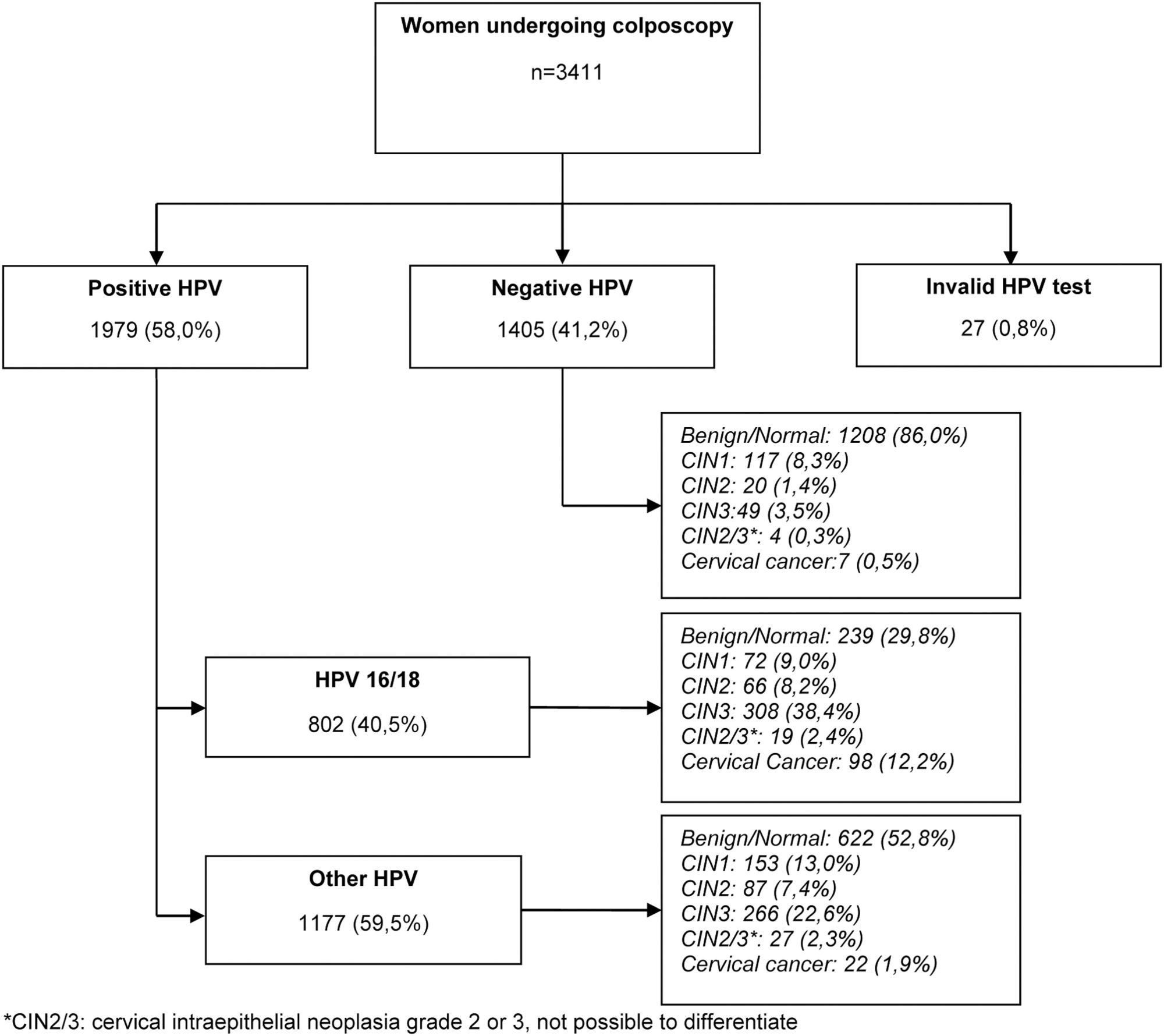Summary
Revista Brasileira de Ginecologia e Obstetrícia. 2006;28(11):686-686
Summary
Revista Brasileira de Ginecologia e Obstetrícia. 2018;40(11):686-692
The aim of the present study was to assess the anthropometric measures, food intake and food cravings during the menstrual cycle of undergraduate students of the faculty of nutrition.
A cross-sectional study was performed with 27 students from a public university in the state of Mato Grosso do Sul, Brazil, who had their food intake evaluated through a 24-hour food recall, their nutritional status evaluated based on anthropometric measures, and food cravings evaluated using the Food Desire Questionnaire. Data were collected during an evaluation in the follicular phase (between the 5th and the 9th day of the menstrual cycle) and another in the luteal phase (LP) (between the 20th and the 25th day of the menstrual cycle). For food intake variables, the analysis of variance (ANOVA) test was used, followed by the Tukey test. The Mann-Whitney test was used for the analysis of food cravings, considering a significance level of 5% (p< 0.05).
The desire for foods rich in sugar, salt, and fat, such as chocolate, pastries, snacks and desserts were higher (p< 0.05) during the premenstrual period, although it did not reflect neither a higher energy intake nor an alteration in the distribution of macronutrients. A higher intake of carbohydrates, proteins, fibers, and calcium was observed during the LP; however, without statistical difference between the groups. There were no differences either in the intake of any food group or in the anthropometric measurements (p> 0.05).
Food cravings of nutrition students differed between the phases of the menstrual cycle; however, with no difference in food intake and in anthropometric measures.

Summary
Revista Brasileira de Ginecologia e Obstetrícia. 2020;42(11):687-689
Summary
Revista Brasileira de Ginecologia e Obstetrícia. 2006;28(11):687-687
Summary
Revista Brasileira de Ginecologia e Obstetrícia. 2003;25(9):687-690
DOI 10.1590/S0100-72032003000900011
PURPOSE: to evaluate a new method of fetal sex determination through the analysis of DNA from maternal plasma. METHODS: peripheral blood (10 mL) was drawn from pregnant women in different gestational ages. Plasma was separated and isolated DNA was submitted to the polymerase chain reaction (PCR) with primers from the Y-chromosome-specific gene DYS14. RESULTS: two hundred and twelve patients were enrolled. PCR results were compared to either confirmatory ultrasonography and/or birth. Agreement was observed in 209 samples. Discordant plasmas had a PCR result of female fetus and all of them were derived from mothers with less than 8 weeks of pregnancy. CONCLUSION: the PCR method developed for fetal sex determination has excellent sensitivity and specificity, permitting its use as a routine test. A PCR result of male fetus presents a higher confidence than a female one, specially in early gestational periods. New applications employing fetal DNA from maternal plasma are being developed and hopefully will allow noninvasive diagnosis of several conditions.

Summary
Revista Brasileira de Ginecologia e Obstetrícia. 2019;41(12):688-696
To evaluate the association between early-onset fetal growth restriction (FGR), late-onset FGR, small for gestational age (SGA) and adequate for gestational age (AGA) fetuses and adverse perinatal outcomes.
This was a retrospective longitudinal study in which 4 groups were evaluated: 1 - early-onset FGR (before 32 weeks) (n=20), 2 - late-onset FGR (at or after 32 weeks) (n=113), 3 - SGA (n=59), 4 - AGA (n=476). The Kaplan-Meier curve was used to compare the time from the diagnosis of FGR to birth. Logistic regression was used to determine the best predictors of adverse perinatal outcomes in fetuses with FGR and SGA.
A longer timebetween the diagnosis and birthwas observed forAGAthan for late FGR fetuses (p<0.001). The model including the type of FGR and the gestational age at birth was significant in predicting the risk of hospitalization in the neonatal intensive care unit (ICU) (p<0.001). The model including only the type of FGR predicted the risk of needing neonatal resuscitation (p<0.001), of respiratory distress (p<0.001), and of birth at<32, 34, and 37 weeks of gestation, respectively (p<0.001).
Fetal growth restriction and SGA were associated with adverse perinatal outcomes. The type of FGR at the moment of diagnosis was an independent variable to predict respiratory distress and the need for neonatal resuscitation. The model including both the type of FGR and the gestational age at birth predicted the risk of needing neonatal ICU hospitalization.

Summary
Revista Brasileira de Ginecologia e Obstetrícia. 2023;45(11):689-698
The present study aims to establish a risk profile for high-grade cervical lesions and cervical cancer (CIN2 + ) in women undergoing colposcopy at the Hospital do Câncer de Barretos, through the analysis of Human Papillomavirus (HPV) infection, cervical cytology, and patient's age.
Retrospective cross-sectional study based on a computerized database of women aged ≥ 18 years old who underwent colposcopy at the Prevention Department of the Hospital do Câncer de Barretos from 2017 to 2019.
A total of 3,411 women were included, 58.0% were positive for high-risk-HPV test, with a higher prevalence of CIN2+ for HPV16 (30.3%) and other HPV (45.0%). Cytological findings that suggest invasive cervical cancer (squamous cells or adenocarcinoma), regardless of the status of HPV test, showed 100% diagnosis of CIN2 + , while atypias that suggest high-grade lesions, HSIL and ASC-H, positive for HPV test, showed in 86 and 55.2%, respectively, diagnosis of CIN2 + . ASC-H cytological results among women aged > 40 years old and negative HPV were mainly associated with benign findings. We observed that ≤ CIN1 has a higher prevalence among older women with negative HPV, while for high-grade lesions there is an increase among young women HPV16- and/or 18-positive. In cancer diagnosis, we observed a predominance of HPV 16/18 regardless of the age group.
The highest risks of precursor lesions and cervical cancer were found among women with positive HPV 16/18 tests and severe cytological atypia in population screening tests. In addition, cytological findings of ASC-H HPV negative in women > 40 years old usually represent benign findings in histological investigation.

Summary
Revista Brasileira de Ginecologia e Obstetrícia. 2002;24(1):69-69
DOI 10.1590/S0100-72032002000100014